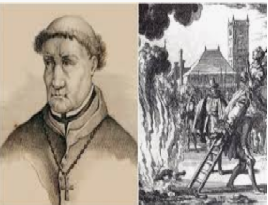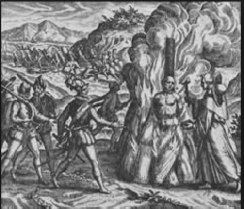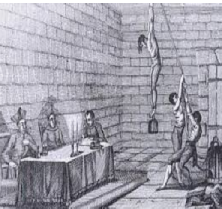|
PART 1 T O P I C |
|
|
|
|
|
|
|
|
|
|
|
|
|
|
|
|
|
|
|
CLICK BUTTON |
|
|
|
|
|
|
|
|
|
|
|
|
|
THE INQUISITION AND THE |
|
|
|
|
JewishWikipedia.info
Understanding what this means and the terror and fear generated
is best felt through historical fiction such as
‘Cathedral of the Sea’ by Ildefonso Falcones pp 548 on and
‘The Saintly Men of Safed’ in ‘The Source’ by James Michener pp652 on.
E-book The Portuguese Inquisition, The Case of Maria Lopes, Burnt at the Stake, 1576 Manuel Azevedo, Fernanda Guimarães
Inquisitors believed they did not punish anyone. They were correcting the errors of others and returning them to God’s embrace. In doing this they were following a handbook written by Pope Gregory IX in 1231. An inquisitorial handbook described someone who managed to escape from an Inquisitorial prison as ‘one who insanely led to reject the salutary medicine offered for his care’ , while the truly repentant Christian was likened to ‘a patient who took his medicine by performing without protest all the penances that had been prescribed by the ‘good doctors’ of the Inquisition.’ (Kirsch ‘The Grand Inquisitor’s Manual p14)
While doing God’s work they collected, all details of their activities with pride and massive attention to detail, Their psychology was that rumours and view of their treatment would frighten the community into compliance. Interrogation, torture and trial were conducted in strict secrecy. Sentences were carried out by the civil authorities at Auto-da-fe.
Thus did the Inquisitor’s come to justify the prosecution of accused heretics as ‘an act of love’ and profound Christian charity towards errant Christians who had put their souls at risk by straying from the benign embrace of ‘Mother Church’ (Kirsch ‘The Grand Inquisitor’s Manual p64) (see also Financing the Inquisition)
GOING TO A NEW COMMUNITY
On Arrival
- An Inquisitor would be preceded by soldiers to show his power and induce fear
- The Inquisitor gave an opening sermon to display Inquisition power at which every male over fourteen and every female over twelve had to attend. Anyone secretly having a belief forbidden by the Church was expected to confess the crime of heresy. Absence was a public admission of guilt.
- Some would be inspired, or terrorized, hoping an early un-coerced confession about themselves or others for a mild punishment to benefit them by giving names that would turn them into witnesses.
- They would try and organise a spy network.
Any local facilities they needed were provided, for example the Toulouse Dominican convent was known as the ‘Hotel de l'lnquisition’, a Franciscan Inquisitor might use a Franciscan monastery, while any objection to using the local town hall or Bishops Palace could leave those objecting being sent to a dungeon
Accusation
The first step was the Edict of Grace. Following the Sunday mass, the Inquisitor would read the edict: it explained possible heresies and encouraged all the congregation to come to the tribunals of the Inquisition to "relieve their consciences." They were called Edicts of Grace because all of the self-incriminated who presented themselves within a period of grace (approximately one month) were offered the possibility of reconciliation with the Church without severe punishment. This was effective, and many voluntarily presented themselves. Self-incrimination, however, was not sufficient; one also had to accuse all one's accomplices. As a result, the Inquisition had an unending supply of informants. With time, the Edicts of Grace were substituted by the Edicts of Faith, which made no offer of painless reconciliation.
Denunciations were anonymous. Defendants had no way of knowing the identity of their accusers. This was one of the points most criticized by those who opposed the Inquisition (for example, the Cortes of Castile, in 1518). In practice, false denunciations were frequent, resulting from envy or personal resentments. Many denunciations were for absolutely insignificant reasons. The Inquisition stimulated fear and distrust among neighbors, and denunciations among relatives were not uncommon.
Detention
After a denunciation, the case was examined by the calificadores, who job was to determine if heresy was involved, followed by detention of the accused. In practice, however, many were detained in preventive custody, and situations of lengthy incarcerations occurred—lasting up to two years—before the calificadores examined the case.
Detention of the accused entailed the "preventive sequestration" of his or her property by the Inquisición. This property paid for procedural expenses, and the accused's own maintenance and costs. Often the relatives of the defendant found themselves in outright misery. This situation was only remedied following instructions written in 1561.
The entire process was undertaken in complete secrecy. The accused were not informed about the accusations levied against them. Months, even years could pass before the accused knew why they were locked up. The prisoners remained isolated, and, during this time, they were not allowed to attend mass nor receive the sacraments. The jails of the Inquisición were not worse than those of civil society, and occasionally they were even much better. Some prisoners died in prison, as was frequent at the time.
The Trial
Inquisition torture chamber
The inquisitorial process consisted of a series of hearings, in which both the denouncers and the defendant gave testimony. A defense counsel was assigned to the defendant—a member of the tribunal itself—whose role was simply to advise the defendant and to encourage him or her to speak the truth. The prosecution was directed by the fiscal. Interrogation was done in the presence of the Notary of the Secreto, who meticulously wrote down the words of the accused (the archives of the Inquisition, in relation to those of other judicial systems of the era, are striking in the completness of their documentation). To defend himself, the accused had two possibilities: abonos (to find favorable witnesses) or tachas (to demonstrate that the witnesses of accusors were not trustworthy).
To interrogate the criminals, the Inquisition used torture, but not in a systematic way. It was applied mainly against those suspected of Judaism and Protestantism, beginning in the sixteenth century. For example, Lea estimates that between 1575 and 1610 the court of Toledo tortured approximately a third of those processed for heresy. In other periods, the proportions varied remarkably. Torture was always a means to obtain the confession of the accused, not a punishment itself. It was applied without distinction of sex or age, including children and the aged.
The methods of torture most used by the Inquisition were garrucha, toca and the potro. The application of the garrucha, also known as the strappado, consisted of suspending the criminal from the ceiling by a pulley with weights tied to the ankles, with a series of lifts and drops, during which arms and legs suffered violent pulls and were sometimes dislocated. The toca, also called tortura del agua, consisted of introducing a cloth into the mouth of the victim, and forcing them to ingest water spilled from a jar so that they had impression of drowning. The potro, the rack, was the instrument of torture used most frequently. The assertion that "confessionem esse veram, non factam vi tormentorum" (the confession was true and free) sometimes follows a description of how, presently after torture ended, the subject freely confessed to his offenses.
Some of the torture methods attributed to the Spanish Inquisition were not used. For example, the "Iron Maiden" never existed in Spain, and was a post-Reformation invention of Germany. Thumbscrews on display in an English museum as Spanish were recently argued to be of English origin. The “Spanish Chair,” a device used to hold the victim while the soles of their feet were roasted, did exist in Spain during the period of the Inquisition but it is uncertain whether it was actually used.
Once the process concluded, the inquisidores met with a representative of the bishop and with the consultores, experts in theology or canon law, which was called the consulta de fe. The case was voted and sentence pronounced, which had to be unanimous. In case of discrepancies, the Suprema had to be informed.
Sentencing
The results of the trial might be:
- The defendant could be acquitted. In actual practice, acquittals were very few.
- The process could be suspended, in which the defendant went free, although under suspicion, and with the threat that their process could be continued at any time. Suspension was a form of acquittal without admitting specifically that the accusation had been erroneous.
- The defendant could be penanced. Considered guilty, he had to abjure (solemnly renounce a belief, cause, or claim). publicly of his crimes (de levi if it was a misdemeanor, and de vehementi if the crime were serious), and condemned to punishment. Among these were the sambenito, exile, fines or even sentence to the galleys.
- The defendant could be reconciled. In addition to the public ceremony in which the condemned was reconciled with the Catholic Church, more severe punishments existed, among them long sentences to jail or the galleys, and the confiscation of all their property. Also physical punishments existed, such as whipping.
- The most serious punishment was relaxation to the secular arm, that implied burning at the stake. This penalty was frequently applied to impenitent heretics and those who had relapsed. Execution was public. If the condemned repented he was garroted before giving his body to the flames. If not, they were burned alive.
- Frequently, cases judged in absentia, or in which the accused died before the trial finished, the condemned were burned in effigy.
- The distribution of the punishments varied much over time. It is believed that sentences of death were frequent mainly in the first stage of the history of the Inquisition.
INSTITUTIONAL STRUCTURE AND PROCEDURE
encyclopedia.com
The modern Inquisitions generally followed the body of jurisprudence developed by the medieval Inquisition, compiled in 1376 by Nicolau Eimeric into the Directorium inquisitorum, revised in the late sixteenth century by Francisco Peña. Unlike their medieval predecessor, however, the Spanish and Portuguese Inquisitions were controlled by the crown, and in Italy, there was considerable secular oversight as well, except in the Papal States. In Spain, Ferdinand created a government board, the Council of the Supreme and General Inquisition, which established policies and procedures, oversaw the appointment of officials and functioning of tribunals throughout the Spanish realms, and served as the court of appeals. Until 1560, the number and territories of the Spanish districts fluctuated considerably; thereafter they remained stable at fourteen peninsular tribunals and four island tribunals (Mallorca, Sardinia, Sicily, and the Canaries). Additional tribunals were added as the empire expanded: Mexico, Lima, Cartagena de Indias, Manila, and finally, the royal court at Madrid.
Portugal's Inquisition was also placed under the direction of a royal board, known as the General Council. Ultimately, there were tribunals in Lisbon, Coimbra, and Evora, plus another in Goa, the Portuguese colony in India.
In Italy, the papacy attempted to exert some control over the Inquisitions outside the Papal States; this process culminated in the establishment of the Congregazione del Sant' Ufficio in 1588. As was the case in Portugal and Spain, the Congregation functioned as the supreme appellate court for the tribunals in Italy. In each of the states with Inquisitions, the network of local tribunals followed the preexisting structure of bishoprics. For example, in the Republic of Venice, aside from the head tribunal in Venice itself, there were tribunals at Brescia, Padua, Udine, Treviso, Cyprus, Rovigo, Picenza, Bergamo, Vicenza, Verona, and Capo d'Istria.
Thanks to a shared legal tradition, the operation of the Inquisition in each area was similar. In Spain each tribunal consisted of one or two inquisitors, a fiscal prosecutor, defense attorney, various employees who were charged with record keeping and care of the prisoners, unpaid theological and legal consultants, and a network of local legal representatives (comisarios) and messengers/jailors (familiars), also unpaid, who created an inquisitorial presence in the hinterland. Strict guidelines established the qualifications for various members of the tribunal. Inquisitors had to be at least forty years old, licentiates or doctors in theology or canon law. After the fifteenth century, few Spanish inquisitors were drawn from the religious orders such as the Dominicans, who had once dominated the medieval institution. Comisarios were drawn from the local secular clergy, and familiars were laymen of uncontested Christian ancestry. Portugal's tribunals were structured along the same lines, while in Italy, often only one inquisitor led the court (in Iberia there were two), while the local legal representatives, known as vicarii, held more power than their Iberian counterparts. Unlike their Iberian counterparts, both the inquisitors and the vicars came from the ranks of the regular religious orders, primarily the Dominicans and Franciscans.
A tribunal generated its cases in a variety of ways. The standard method was for the inquisitor to go on a visitation of his district. First, the inquisitor would issue the Edict of Grace, a sermon that defined the heresies sought after and promised leniency for those who confessed within thirty days. The follow-up sermon, the Edict of Faith, offered no leniency but continued the exhortations to confess. Voting members of the tribunal would examine the resulting confessions and issue a warrant for arrest. Once detained, the prisoner disappeared to the outside world: in order to inspire fear and prevent reprisals, the courts attempted to conduct their business in the strictest secrecy. Similar secrecy within the proceedings kept the prisoner at a disadvantage. Not until well into the trial did the prisoner learn the charges against him, and never was the accused allowed to know who had given evidence against him—or, once freed, to speak about his experiences. With the inquisitor acting as both judge and investigator, the prosecution presented its case first, and the defendant, with the aid of a court-appointed lawyer, could respond. At this point, if the defendant's confession was not seen as sufficient, the tribunal would vote on the question of torture: what kind and how much. In reality, torture was employed rarely (in less than 3 percent of cases) and frequently was overcome. The large majority of cases ended in guilty verdicts. In Spain and Portugal, the final act in the trial was the public auto-da-fé, where prisoners were sentenced amid great ceremony; actual punishments were carried out separately. An important tool of the Iberian Inquisition was public humiliation: those convicted of serious offenses were required to wear the sanbenito, a distinctive outer tunic that was also displayed in the convict's parish church.
Abolition came slowly, with the advance of the Enlightenment and then French troops to southern Europe. Generally, the Italian tribunals were disbanded between 1774 and 1800, and the Iberian ones disappeared between 1812 and 1834, although the Spanish and American tribunals effectively ended operation in 1820. The fate of each tribunal's archives is capricious: some survive virtually intact, while others disappeared during the Napoleonic Wars. Major repositories exist in the Archivo General de la Nación (Mexico), Arquivo Nacional da Torre do Tombo (Lisbon), Archivo Histórico Nacional (Madrid), and in the Archivi dell'Inquisizione Romana (The Vatican, opened in 1998), but substantial numbers of trials and other papers remain outside these repositories.)
Considerable controversy exists over how many individuals were tried and executed by the courts, but the loss of so many records makes precise accounting impossible.
A survey of nineteen Spanish tribunals from 1540 to 1700 yielded 49,092 cases. The Portuguese Inquisition tried 44,817 cases between 1536 and 1767, the most active court being Goa. Naples between 1564 and 1740 tried 3,038 cases, and Venice between 1547 and 1794 tried 3,592 cases. The death sentence was invoked in less than 5 percent of all trials. In Spain and Portugal the first victims were conversos, many of whom were sentenced to death (often in absentia), while the Italian courts pursued Protestants.
With time, the tribunals changed their focus and moderated their severity: in Spain, converted Muslims (Moriscos), homosexuals, Protestants, witches, and ordinary Spaniards guilty of making crude theological statements all at some point became the focus of the tribunals' attention. Indeed, relatively minor crimes such as blasphemy accounted for much of the Spanish Inquisition's caseload. In addition to punishing religious crimes, all of the Inquisitions were responsible for enforcing censorship of printed materials and searching for contraband.
THE
INCREDIBLE
STORY OF THE JEWISH PEOPLE



HOW WAS THE SPANISH INQUISITION ORGANISED?
